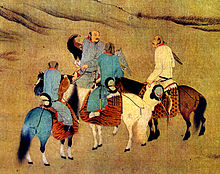ชาวคีตัน
 ภาพวาดชาวคิตันขณะออกล่าสัตว์กับนกอินทรีสมัยราชวงศ์ซ่ง | |
| ภูมิภาคที่มีประชากรอย่างมีนัยสำคัญ | |
|---|---|
| เอเชียตะวันออก และเอเชียกลาง | |
| ภาษา | |
| คีตัน จีนกลาง |
ชาวคีตัน (จีน: 契丹) เป็นชนเผ่าเร่ร่อนจากเอเชียตะวันออกเฉียงเหนือ ตั้งแต่คริสต์ศตวรรษที่ 4 พวกเขาอาศัยอยู่ในพื้นที่ส่วนหนึ่งของมองโกเลีย ภาคตะวันออกเฉียงเหนือของจีน และรัสเซียตะวันออกไกลในปัจจุบัน
ในฐานะผู้คนที่สืบเชื้อสายมาจากโปรโต-มองโกลผ่านเซียนเป่ย์[1][2] ชาวคีตันพูดภาษาคีตันที่สูญพันธุ์ไปแล้ว ซึ่งเป็นภาษาพารามองโกลิกที่เกี่ยวข้องกับกลุ่มภาษามองโกล[3] ชาวคีตันเป็นผู้ก่อตั้งและเป็นผู้นำราชวงศ์เหลียว ซึ่งครอบครองพื้นที่กว้างใหญ่ของไซบีเรีย มองโกเลีย และจีนตอนเหนือ ชาวคีตันแห่งราชวงศ์เหลียวใช้ระบบการเขียน 2 แบบสำหรับภาษาของตน คือ อักษรคีตันเล็กและอักษรคีตันใหญ่
อ้างอิง[แก้]
- ↑ "China's Liao Dynasty". Asia Society.
- ↑ Xu Elina-Qian (2005). Historical Development of the Pre-Dynastic Khitan. University of Helsinki. p. 99. quote: "According to Gai Zhiyong's study, Jishou is identical with Qishou, the earliest ancestor of the Khitan; and Shihuai is identical to Tanshihuai, the Xianbei supreme chief in the period of the Eastern Han (25–220). Therefore, from the sentence "His ancestor was Jish[ou] who was derived from Shihuai" in the above inscription, it can be simply seen that the Khitan originated from the Xianbei. Since the excavated inscription on memorial tablet can be regarded as a firsthand historical source, this piece of information is quite reliable."
- ↑ Janhunen, Juha (2006). "Para-Mongolic". In Janhunen, Juha (ed.). The Mongolic Languages. Routledge. p. 393 of pp. 391–402.
